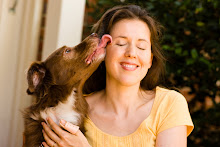
Our dog Bagel is a yellow lab mix, and it has galled us to no end that he is not a natural retriever. Chase the ball and keep it? Yes. Chase the ball and bring it back? Not so much. We would see the labs at the dog park faithfully fetching their tennis balls, and we’d look at Bagel and sigh.
But no more -- I finally solved the mystery of how to get Bagel to fetch instead of play keep-away.
My inspiration came from Patricia McConnell’s excellent book, The Other End of the Leash. In the book she talks about a seminar where she has her dog drop a ball, and then pets and praises the dog for doing it. She asks the audience to grade her on how effectively she reinforced the dog for dropping the ball. They gave her an A, but she gave herself a D. Why? Because, as she was petting the dog, he was ducking his head, annoyed, while he kept his laser-like focus on the ball. The thing he wanted most in the world was to have the ball back. She was illustrating that sometimes the best reinforcement for a successful “drop it” is to just give the dog back whatever he just dropped.
Aha! The thing that Bagel wants more than anything in the world after retrieving a ball is to (1) keep the ball, and (2) have us chase him for it. That was the reward he would work for, not food. Now I just needed to teach him that if he brought the ball back to me and dropped it, I would give the ball back to him and chase him for it.
But how to bridge the gap? Like so many retrievers, when Bagel fetched the ball, he would only come back within 20 feet of us and dance around, trying to get us to chase him. I had already tried giving him a treat for bringing the ball back, but that only worked once - he wanted to keep the ball more than he wanted any food. Plus, right now he’s not allowed any treats -- even chicken - until we figure out his food allergies.
I solved the problem by filling a squirt tube with some of Bagel’s canned hypoallergenic food. When he brought the ball back and did his dance routine, I stayed still in my crouched position, holding the food out in one hand, and my clicker in the other. Bagel danced all around and taunted me with the ball, but I stayed still and quiet and stared straight ahead. After a minute or two, he came over to investigate. When he smelled the food, he dropped the ball to eat it. I instantly clicked my clicker, gave him the food, gave him the ball back, and got into my exaggerated cat-stalking pose to let him know we were playing chase. Then I chased him all around until he lay down -- his signal to me that he’s had enough chasing.
It took a few times before he got the idea of bringing the ball right to me and dropping it immediately. (On the first throw, he still prefers to dance around with it for a minute or two by himself, but that’s okay. I just stay crouched and wait for him to bring it to me.) After a few days, I was able to eliminate the food -- when he dropped the ball, I clicked, and launched right into the game of chase.
Voilà, a perfect fetch.
And a few useful pointers if you want to try this yourself:
Unless your dog feels the need to retrieve, keep it brief - I ask Bagel to fetch three times max.
Experiment with not throwing the ball again right away. We used to take the ball from Bagel and throw it again immediately, and I think that’s why he gave up on fetch to begin with - it was all work and no play. The part that’s fun for him is getting chased once he has it.
Let your dog have a way to signal you that enough is enough. When Bagel lays down, I walk over and sit down with him and we take a little break.
Chasing your dog in play can be dangerous if your dog can’t distinguish between when you are initiating a chase game and when you are grabbing her in an emergency. To avoid this, you want to have a very clear signal for starting a chase game, and very clear body language when you are playing chase. When I’m playing chase with Bagel, I stare right at him and use my exaggerated-slow-motion-cat-stalking walk. When I’m not doing that, Bagel knows not to dash away from me. (Some people try to trick their dogs during chase games by wandering up to them casually, and then springing at them at the last second. That’s a bad idea though, because the last thing you want is your dog diving away from you playfully if you are trying to get ahold of him in a dangerous situation.)
Also, every dog owner should own and practice the technique in Leslie Nelson’s excellent DVD, Really Reliable Recall, available on Amazon.com.












